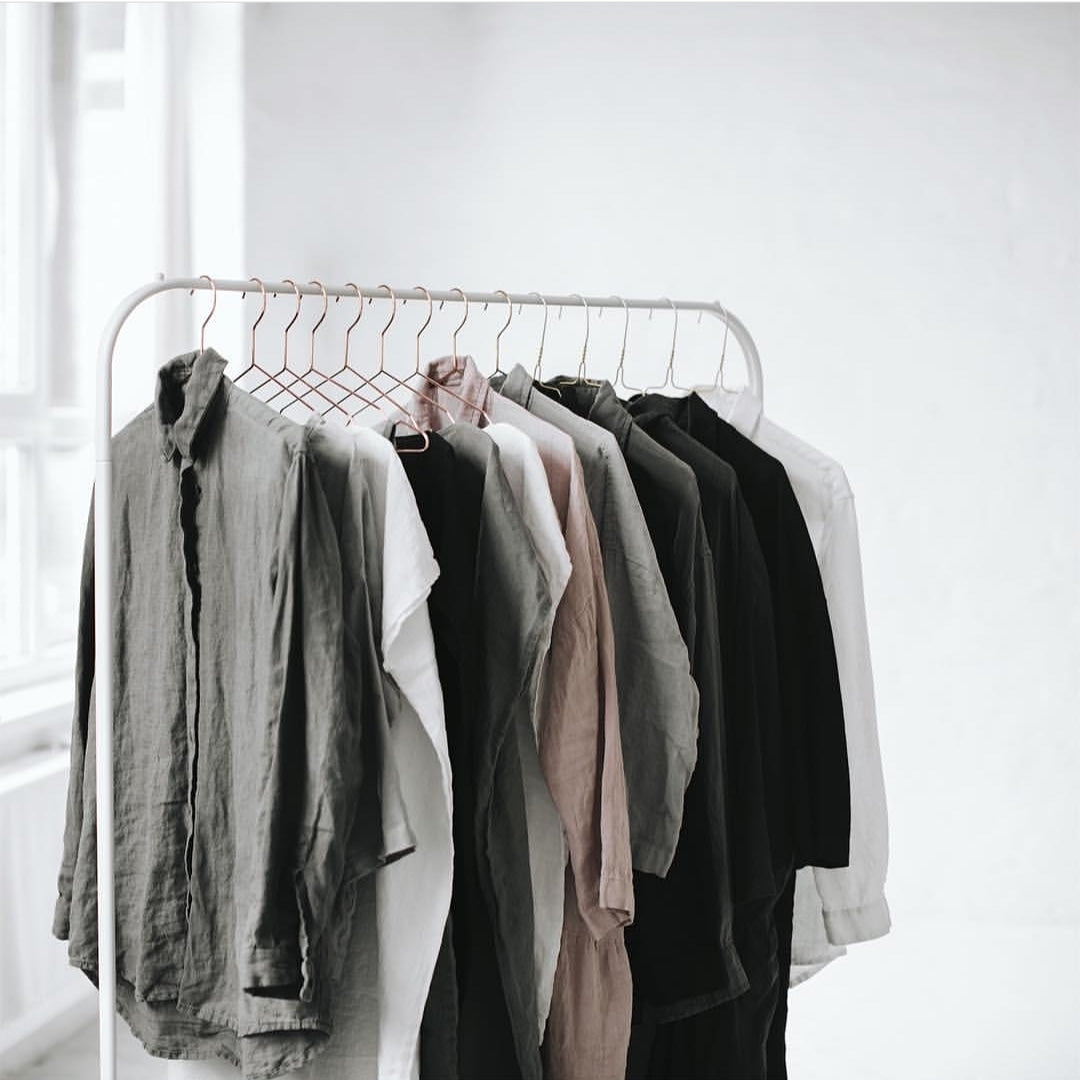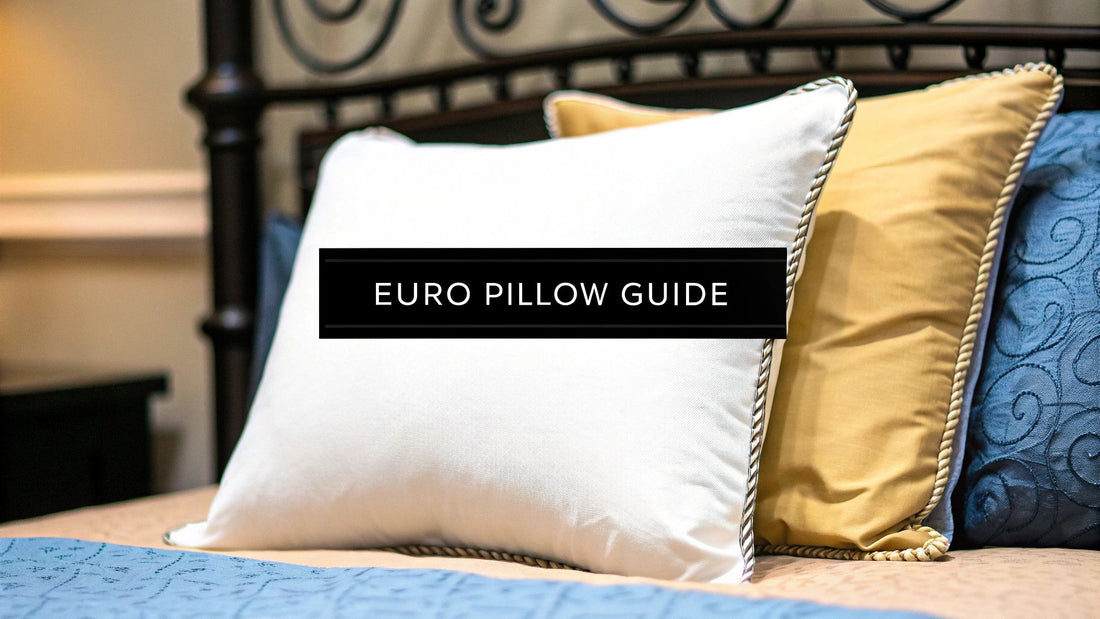A European pillow case is that large, decorative square you often see propped up against the headboard of a beautifully made bed. Typically measuring 65cm x 65cm, its main job isn't for sleeping on but rather for adding a touch of structure and luxury to your bedroom styling. Think of it as the foundation piece that elevates your entire bedding look.
Unlike the standard rectangular cases most Kiwis are used to for sleeping, the European pillow case plays a purely aesthetic role, acting as a plush, supportive backdrop for your regular pillows and any smaller cushions.
The Role of a European Pillow Case in Bedroom Design
Ever wondered how luxury hotels or magazine shoots get that full, inviting, 'sink-right-in' look for their beds? More often than not, the secret weapon is a pair of perfectly placed European pillows. They're more than just a simple pillow cover; they are a fundamental design element that turns a bed from a place to sleep into the sophisticated centrepiece of the room.
Picture them as the architectural support for your entire pillow arrangement. While your standard pillows are all about comfort and a good night's rest, European pillows stand tall and proud. They create a solid, visually pleasing canvas that makes everything layered in front of them—from your sleeping pillows to smaller accent cushions—really stand out.
More Than Just a Square Shape
The distinct square shape of a European pillow case, often called a Euro sham, is what truly sets it apart from the familiar rectangular pillows in most New Zealand homes. It’s this simple geometric difference that makes them so incredibly effective for layering.
- It Adds Height: A European pillow instantly draws the eye upward, giving your bed a grander, more finished appearance.
- It Provides Structure: Their firm, upright nature creates the perfect backrest for sitting up to read a book or enjoy a morning coffee in bed.
- It Creates Depth: By layering different shapes and sizes, you move your bed from being flat and one-dimensional to looking rich, textured, and incredibly cosy.
This simple diagram breaks down what makes a European pillow case what it is.
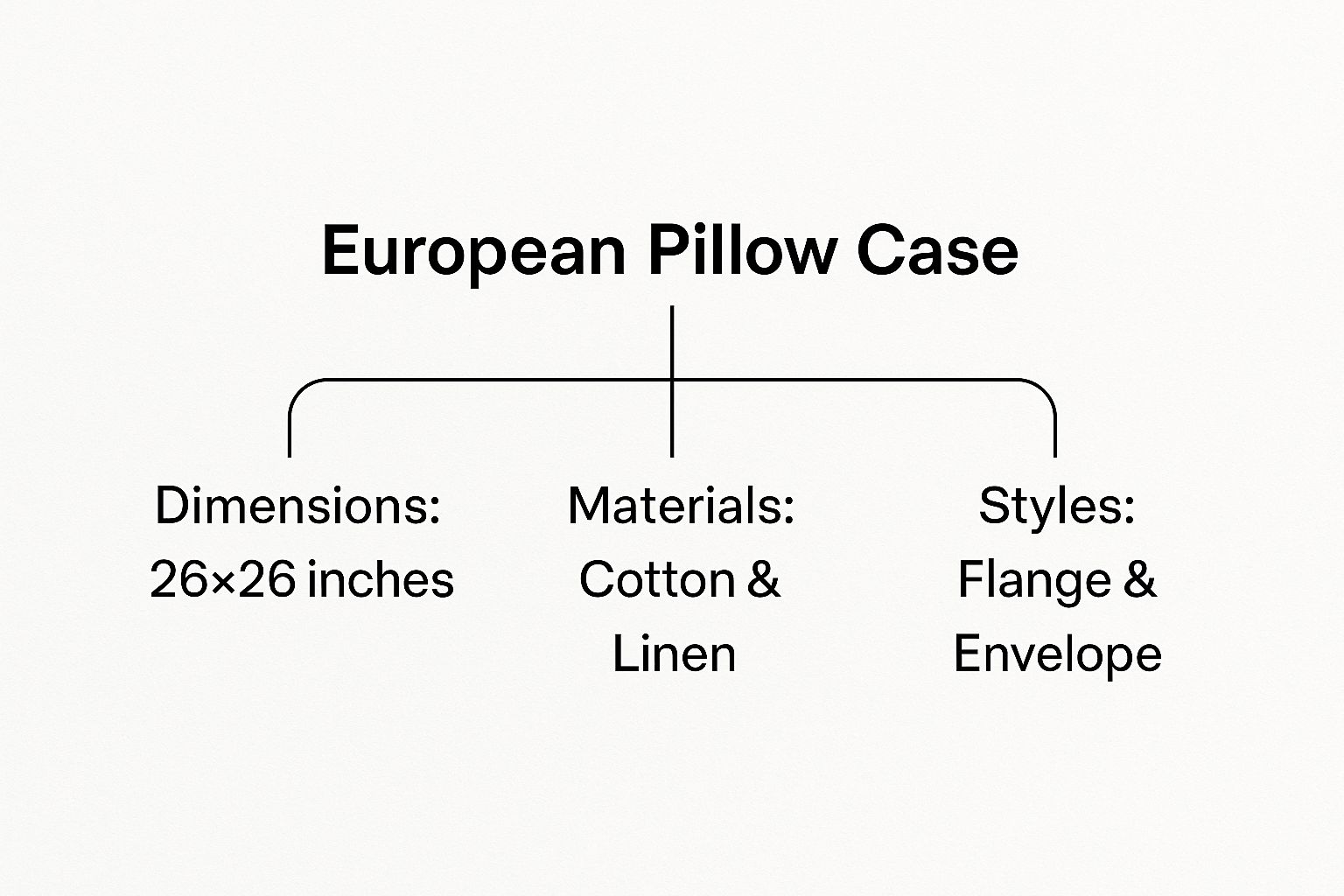
As you can see, it's the combination of its generous square dimensions, the choice of quality materials like cotton or linen, and finishing touches like a flange border or envelope closure that define this versatile piece of bedding.
European vs Standard Pillow Cases At a Glance
To make it even clearer, let's quickly compare the two side-by-side. While both cover pillows, they serve very different purposes on your bed.
| Feature | European Pillow Case | Standard Pillow Case |
|---|---|---|
| Primary Shape | Square | Rectangular |
| Typical NZ Size | 65cm x 65cm | 50cm x 75cm |
| Main Function | Decorative & Structural | Functional (for sleeping) |
| Placement on Bed | Against the headboard | In front of European pillows |
| Common Closures | Envelope, Zip, Ties | Simple open-end |
This table really highlights how the European pillow case is designed for style and support, while the standard pillow case is all about sleeping comfort.
Pillowcase vs Euro Sham: A Key Distinction
It's also useful to know the subtle difference in terminology between a 'pillowcase' and a 'Euro sham'. In simple terms, a standard pillowcase is functional—usually open at one end and made from soft, breathable fabric you’d want to sleep on.
A Euro sham, on the other hand, is built for style. It’s the more decorative version, often featuring details like a wide fabric border (known as a flange), detailed stitching, or a tidy hidden closure on the back, like an envelope tuck or a zip. Its job is purely to look good.
To see some beautiful examples and get more ideas, you can explore a curated collection of high-quality options and learn how these European pillow cases can refine your space.
Getting the Size of Your European Pillow Case Right
Nailing the dimensions of your bedding is the secret sauce to getting that polished, professionally styled look you see in magazines. And when it comes to the European pillow case, its specific size isn't just a minor detail—it's the whole point. Get the size wrong, and the entire layered effect can fall flat, looking awkward and untidy.
Imagine you're framing a beautiful piece of art. A frame that’s too big or too small just looks off and can completely spoil the picture. It's the same idea here. A correctly sized European pillow case makes sure your pillow insert fills it out perfectly, creating that firm, supportive, and visually stunning backdrop for your bed.
The Go-To Euro Size in New Zealand
Here in New Zealand, and in most parts of the world, the standard size for a European pillow is a perfect square: 65cm x 65cm (that's about 26 x 26 inches). This isn't just some random number; it's a dimension that was chosen for its incredible versatility and visual balance.
This generous square shape is large enough to make a real statement but is also scaled perfectly to work across the different mattress sizes we have in our homes. Whether you've got a roomy King or a cosy Double bed, this size provides the ideal structure and proportion.
Why the 65cm x 65cm Square Is So Effective
The real magic of the 65cm square is how it creates a full, seamless headboard effect. The dimensions are designed so the pillows can sit neatly side-by-side, spanning the width of the bed without any weird gaps or messy overlapping.
It’s actually pretty straightforward. Here’s a quick guide to how they fit:
- King Bed: Three European pillows line up perfectly across the width, giving you that opulent, five-star hotel look.
- Queen Bed: Two is the magic number here. They fill the space beautifully to create a plush and complete backdrop.
- Double Bed: Two also works wonderfully on a double, offering a full and luxurious feel on a slightly smaller frame.
This consistent sizing really takes the guesswork out of styling, making it easy to achieve a sophisticated, put-together look every time.
Looking Beyond the Basic Size: Decorative Edges
While the internal dimensions are almost always 65cm x 65cm, you'll often come across different terms that describe the decorative edges of a European pillow case, sometimes called a sham. These little details can change the overall visual size and style of the pillow once it's on your bed.
The most common decorative touch you’ll find is something called an Oxford border, or a flange.
An Oxford border is essentially a wide, decorative fabric frame that extends out from the main body of the pillow case. This flat border is usually around 5-7cm wide and adds a touch of classic elegance, making the pillow look a bit larger and more substantial.
Knowing this little detail helps you pick the right style for your room. A simple case without a flange (often called a 'housewife' style) gives a clean, minimalist vibe. An Oxford flange, on the other hand, offers a more traditional, tailored finish that adds a lovely bit of softness and dimension.
How to Guarantee a Perfect, Plump Fit
To get that plump, full look we're all after, the pillow insert (the actual pillow) needs to match the case's dimensions. You should always be buying a 65cm x 65cm pillow insert to go inside your European pillow case.
A really common mistake is to use an undersized insert. This just leads to a saggy, limp-looking pillow that won't stand up straight. A snug fit is non-negotiable if you want to create that firm, supportive foundation for a beautifully layered bed. If you’re ever in doubt, just measure your inserts to make sure they'll fill the case right out to the corners.
Choosing the Best Fabric for Your Euro Sham
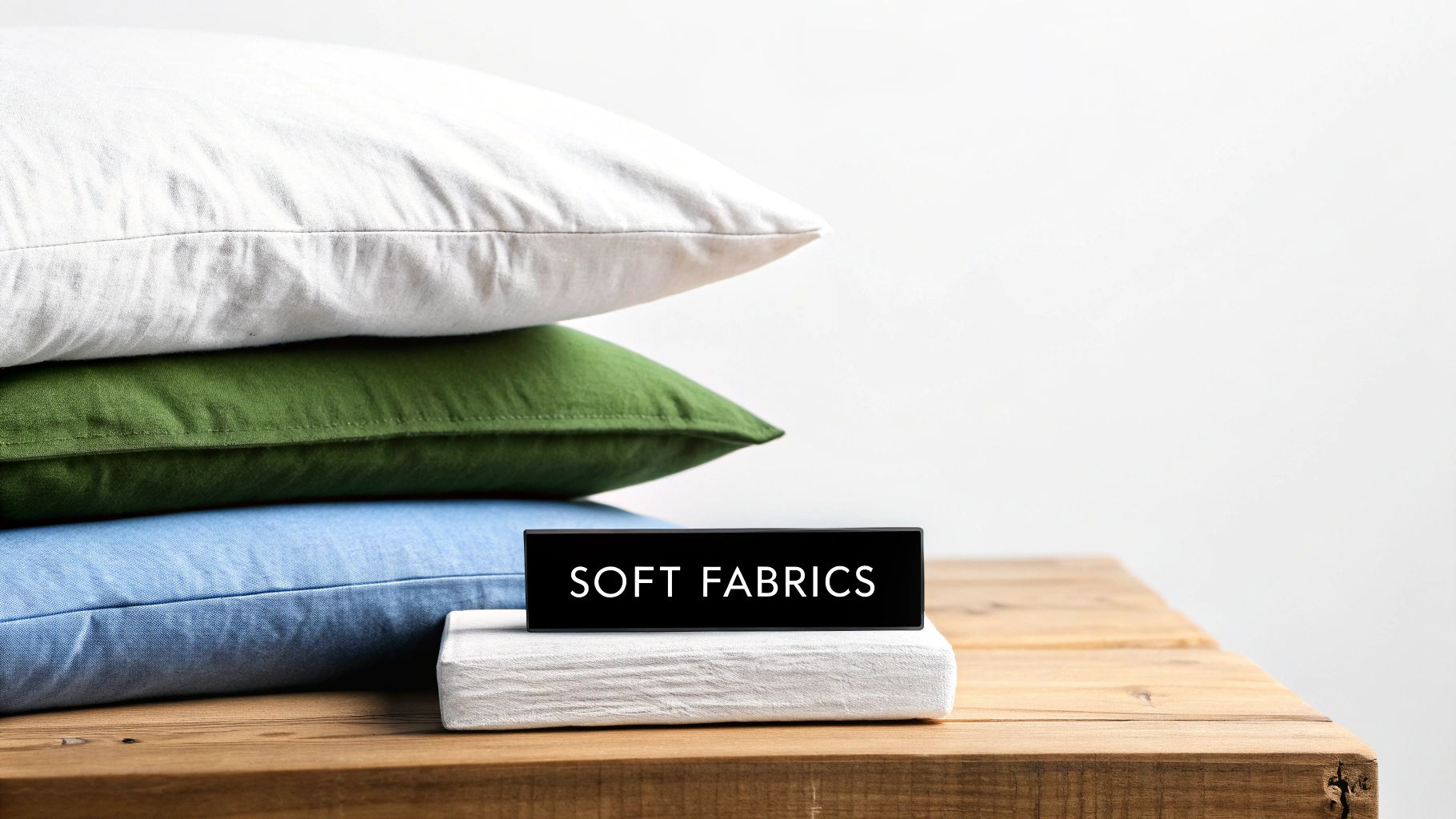
The fabric you choose for a European pillow case does so much more than just look good—it sets the entire tone for your bedroom. The right material is a balancing act between comfort, style, and how well it holds up over time. Let's break down the most popular options.
Breathable Linen for a Relaxed Style
If you're after that breezy, laid-back feel, linen is your go-to. It instantly brings to mind coastal homes and minimalist aesthetics, creating a sense of effortless style. Its natural fibres are brilliant at wicking away moisture and letting air flow freely, which is an absolute blessing during those warm NZ summers.
- It has a natural ability to manage moisture, keeping you crisp and cool.
- The subtle, organic texture adds a touch of casual charm to any room.
- Look for Airo washed linen, which gets softer with every wash without going floppy.
- It's often a great sustainable choice, aligning with eco-conscious values.
Straight out of the packaging, linen can feel a little crisp. But give it a few washes, and it transforms, softening beautifully and developing those gentle, characteristic creases that are all part of its charm.
Crisp Cotton Percale for a Timeless Look
For that classic, five-star hotel feeling, you can't go wrong with cotton percale. It has a crisp, matte finish thanks to its tight weave, feeling wonderfully smooth and cool against the skin.
- A good percale has a thread count of 200–400 threads per square inch, making it strong and durable.
- It’s incredibly easy to care for (just pop it in the machine) and highly breathable for comfortable nights.
- Being natural cotton, it works with your body, adapting to your skin temperature for an undisturbed sleep.
- It has a versatile drape that partners perfectly with other layers of bedding.
With percale, you get that satisfyingly crisp sheet that only gets softer with use. It makes the simple act of making the bed feel fresh and orderly.
Silky Sateen for a Subtle Sheen
Sateen is all about quiet luxury. Its unique weave allows it to catch the light, creating a lustrous sheen that can turn a simple European pillow case into a sophisticated statement piece.
- Thread counts typically range from 300–600 for a buttery-smooth feel.
- The way it reflects light gives it a gorgeous, gentle glow.
- It drapes beautifully, contouring elegantly around the pillow.
- Sateen tends to hold a little more warmth, making it a cosy choice for cooler nights.
The sheer softness of sateen is undeniable. It’s the perfect fabric for when you want to treat yourself to that hotel-inspired indulgence without the hefty price tag.
Rich Velvet for Warmth and Depth
Velvet offers something entirely different: a deep, tactile comfort. Its plush surface plays with light in a way that adds texture and dimension from every angle.
- Its dense weave and soft pile feel incredibly luxurious to the touch.
- Velvet is fantastic for winter or as a decorative accent to add richness.
- You’ll often find it in deep, saturated colours that can really anchor a room's design.
- While it needs a bit more gentle care, the lush, inviting look is well worth it.
Because of its weightier feel, velvet works best as an accent piece, especially during the warmer months, rather than for a sham you’ll be sleeping on every night.
Here in New Zealand, our bedding choices are often guided by our love for natural, sustainable materials. While globally, silk pillowcases dominate the luxury market—making up 43.8% in 2023—Kiwis tend to gravitate towards eco-friendly fibres like quality wool and organic cotton. It’s a reflection of our country’s heritage and focus on sustainability. You can see this trend in popular retailers like Spotlight and Adairs New Zealand, which offer everything from standard cottons to specialised hypoallergenic options. For a deeper dive into these trends, check out the market analysis from Grand View Research.
How to Choose the Right Fabric for You
| Factor | Best Fabric Choice | Why It Works |
|---|---|---|
| Sleep Temperature | Linen or Percale | Both are breathable and excellent at wicking away moisture. |
| A Touch of Luxury | Sateen or Velvet | Perfect for adding sheen and a truly indulgent feel. |
| Eco-Conscious | Organic Cotton or Wool | Great choices for their sustainable and natural origins. |
| Easy Maintenance | Cotton Percale | Famously durable and easy to machine wash. |
Thinking about your needs in these simple categories will help you land on the perfect fabric that fits your decor, your sleep style, and your laundry routine.
“Selecting the right material is as important as the design itself.” - Leading NZ Interior Stylist
With this insight, you're ready to choose a European pillow case fabric that will truly transform your bed into a personal sanctuary.
Next, we’ll dive into some styling techniques to make those new shams the star of your bedroom.
Pro Tip: Rotate your Euro shams once a month to ensure they wear evenly.
Enjoy your newfound comfort
How to Style European Pillows Like a Pro
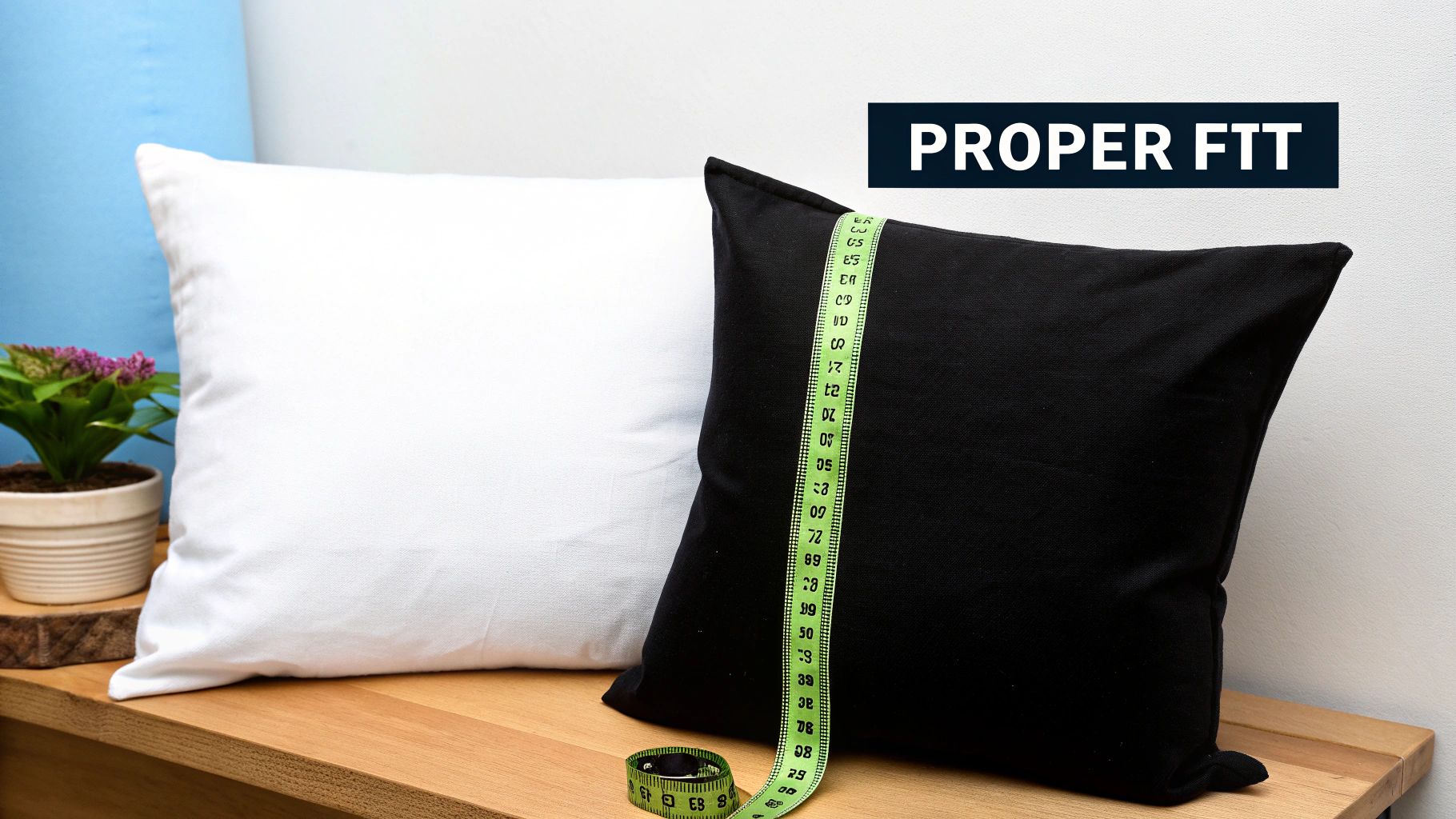
Ever wondered how to get that plush, inviting bed you see in magazines? The secret isn't as complicated as you might think. It all comes down to layering, and the hero of that story is the European pillow.
Think of your Euro pillows as the structural backbone of your bed's design. They’re the first, most important layer, creating that essential height and visual anchor against the headboard. They provide the perfect canvas, allowing your regular sleeping pillows and decorative cushions to really pop. Getting this foundation right is the key to transforming your bed from flat and functional to a luxurious centrepiece.
Mastering the Art of Layering
The quickest way to create a professionally styled bed is to layer pillows of different shapes and sizes. This simple trick breaks up the visual monotony and introduces a sense of depth and texture that feels incredibly inviting. The idea is to build a gentle cascade of pillows, starting with the tallest at the back and moving forward.
This is where your European pillow case collection comes into play. They should always stand tall and crisp against the headboard, creating a solid, satisfying backdrop for everything else. This first step is what gives your bed that sought-after hotel-style fullness.
Designer Formulas for NZ Bed Sizes
While you can always get creative, there are a few classic, no-fail formulas that work beautifully for standard New Zealand bed sizes. These arrangements guarantee a balanced, sophisticated look every time, taking all the guesswork out of the process.
For a Queen Bed: The Classic 2-2-1
This is perhaps the most popular and harmonious arrangement for a queen-sized bed. It's symmetrical, elegant, and always looks polished.
- Start with Two European Pillows: Prop two Euro pillows in their shams squarely against the headboard. They should sit neatly side-by-side, spanning most of the bed's width.
- Add Two Standard Pillows: In front of the Euros, lean two of your standard sleeping pillows. The contrast between the square and rectangular shapes is what makes this work so well.
- Finish with One Accent Cushion: Complete the look with a single decorative cushion at the front. This is your chance to inject a little personality with a pop of colour, a unique shape like a bolster, or an interesting texture.
For a King Bed: The Grand 3-2-1
With the extra width of a king bed, you need a slightly fuller arrangement to keep it from looking sparse. The solution is simple: just add one more European pillow.
- Three European Pillows: Arrange three Euros in a neat row against the headboard to create a lush, complete backdrop.
- Two King or Standard Pillows: Layer two king-sized pillows (or even standard ones) in front of the Euros.
- One to Three Accent Cushions: You have more room to play here. Finish with a trio of smaller cushions, or for a cleaner, more modern aesthetic, use a single long bolster pillow.
This layered approach isn't just for looks—it's incredibly practical, too. Those sturdy European pillows offer fantastic back support for reading in bed or enjoying a morning coffee, turning your bed into a comfortable, multi-functional retreat.
Mixing Colours and Textures
Once you’ve settled on your pillow formation, the real fun begins. Mixing colours, patterns, and textures is what will elevate your bed from simply well-arranged to truly well-designed. This is how you infuse your personal style and create a bed with real character.
A great place to start is by pairing neutral, solid-coloured Euro shams with more dynamic standard pillowcases. For example, you could use a calm, earthy linen European pillow case as your base. Then, layer standard pillowcases with a subtle floral print or a contemporary geometric pattern in front. The contrast creates instant visual interest without feeling chaotic.
And don’t forget about texture! The interplay of different materials is what makes a bed feel truly luxurious.
- Texture Adds Depth: Imagine pairing crisp cotton with plush velvet, or relaxed, slubby linen with a smooth, silky sateen. A chunky knit throw tossed at the foot of the bed adds another tactile element.
- Colour Creates Mood: Stick to a cohesive colour palette. You could explore different shades of the same colour for a sophisticated monochromatic look or pick complementary colours for a more vibrant feel.
- Pattern Provides Personality: Even a single patterned cushion can act as a statement piece, tying all the other colours and textures together.
By using these straightforward techniques, you can arrange your European pillows like a seasoned pro. You’ll end up with a beautifully composed bed that looks incredibly inviting, feels wonderfully luxurious, and is a perfect reflection of your personal taste.
Pillowcase vs Sham: What Is the Difference?
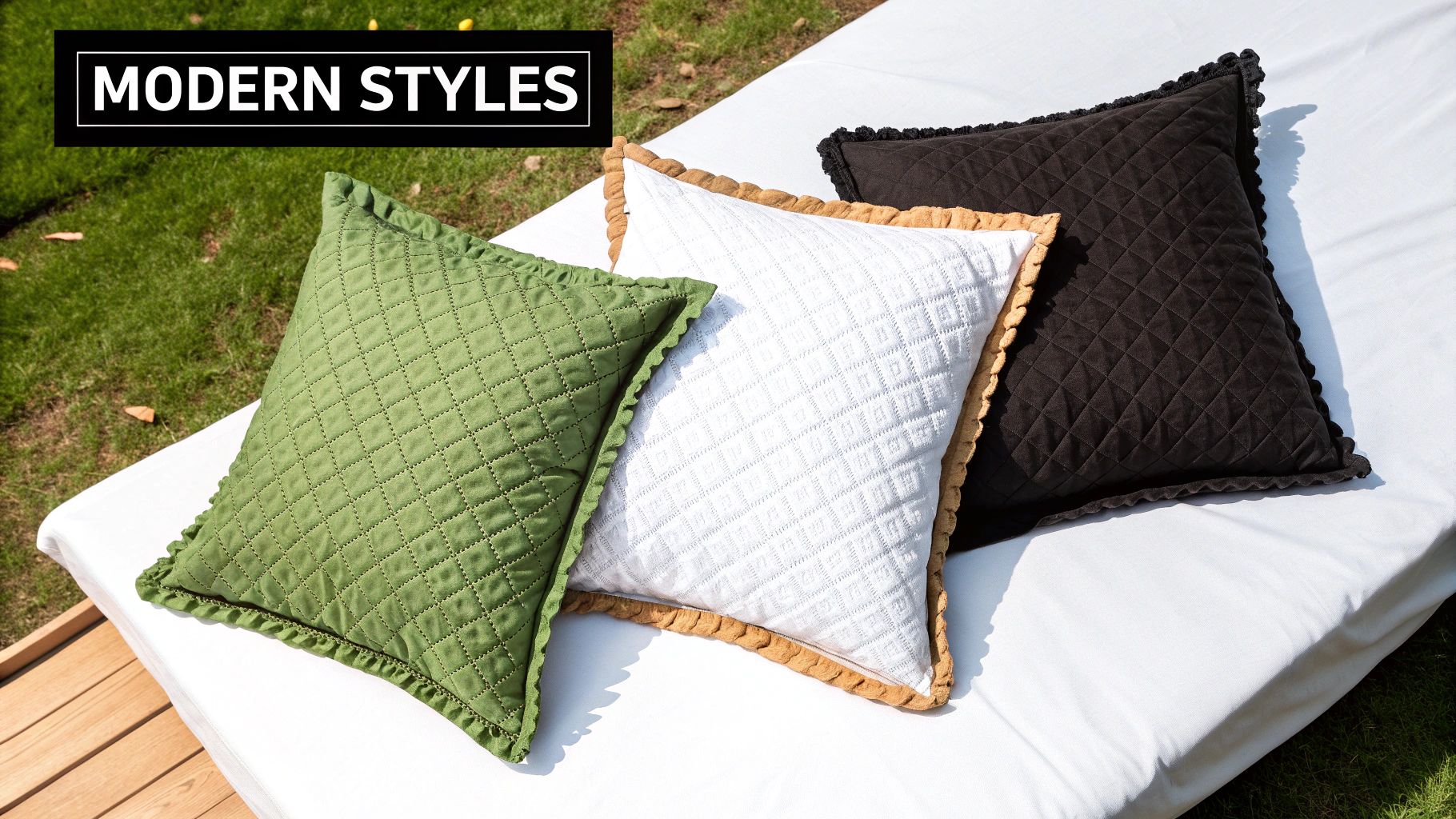
When you're shopping for new bedding, it’s easy to get tangled in the terminology. Two words that often cause confusion are 'pillowcase' and 'sham'. While they both cover a pillow, they play very different roles on your bed, and knowing the difference is the secret to creating a beautifully styled space.
Think of it this way: a pillowcase is your comfortable, everyday t-shirt, while a sham is the stylish jacket you add to complete an outfit. One is all about function and sleep comfort; the other is purely about aesthetics and presentation.
The Humble Pillowcase: Built for Comfort
A standard pillowcase has one main job: to give you a soft, clean, and comfortable place to rest your head. Everything about its design serves this purpose.
- Simple Construction: It's usually just a sleeve of fabric, open at one end. This makes it a breeze to slip the pillow in and out for regular washing.
- Functional Fabric: Pillowcases are almost always made from soft, breathable materials like cotton or linen because they're designed to feel great against your skin all night long.
- Minimalist Edges: You won't find wide, decorative borders or fussy trims. The focus is on sleeping comfort, without anything scratchy or bulky getting in the way.
In short, the pillowcase is the practical, hardworking hero of your bedding. It protects your pillow and helps you get a good night's sleep.
The Elegant Sham: Designed for Style
A sham, on the other hand, is made for show. Its role is to dress up the bed and tie the whole look of the room together. This is especially true for a European pillow case, which is almost always a sham thanks to its decorative function.
Shams have a few key features that set them apart:
- Decorative Details: They often have wide fabric borders (called an Oxford flange), quilted patterns, embroidery, or other interesting textures.
- Concealed Closure: Instead of an open end, shams have a tidy closure on the back, usually an overlapping envelope tuck or a hidden zip. This creates a much cleaner, more polished look from the front.
- Upright Structure: The fabric is often a bit heavier or more structured, which helps the pillow stand up crisply against the headboard for that perfect 'made bed' look.
Because of these decorative touches and back closures, shams aren't really meant for sleeping on. You typically take them off the bed at night or just set them aside.
By understanding this key difference, you can shop with confidence. When you are looking for a cover for your large, square European pillows, you are almost always searching for a 'Euro sham'—a piece designed to build that perfect, layered look.
This distinction matters to shoppers across New Zealand, where the home textiles market is buzzing. The bedding segment is projected to grow at a CAGR of 6.4% between 2025 and 2035, showing a strong local appetite for quality products. This growth is fuelled by a focus on wellness and the huge range of options now available online, from eco-friendly wool to cooling fabrics. To dive deeper into these trends, you can explore the full research on the pillowcase market from datahorizzonresearch.com.
How to Care for Your European Pillow Cases
You’ve invested in a beautiful European pillow case, and now you want to keep it looking and feeling its best for years to come. Think of it like any other quality item you own – a little care goes a long way. Different fabrics have their own unique personalities, and that means they also have their own care needs to maintain their colour, softness, and shape.
The care label is always your best friend and the first place you should look for guidance. But generally speaking, when it comes to premium fabrics, a gentle touch is key. Think cool washes, mild detergents, and low heat. This simple approach protects the delicate fibres from the stress that can cause fading and wear over time.
Washing and Drying Different Fabrics
Every material has its own little quirks when it comes to laundry day. Linen, for example, has that wonderful quality of getting softer and more inviting with every wash, while that crisp, hotel-style cotton percale needs a specific touch to keep its signature finish.
-
Linen: Pop your linen cases in a cool, gentle cycle with a mild liquid detergent. Linen absolutely loves water, so give it plenty of room to dance around in the washing machine. Tumble dry on a low heat and, here's the trick, pull it out while it's still a little damp. This is the secret to minimising wrinkles. For a deep dive, check out our guide to washing and caring for luxury European linen.
-
Cotton (Percale & Sateen): Good news – these are pretty hardy. A warm machine wash is usually fine. To maintain that classic crispness of percale, iron it while it's still slightly damp. For sateen, a low tumble dry will help protect its beautiful, subtle sheen.
-
Delicate Fabrics (Velvet & Silk): These require the most care and attention. For velvet, professional dry-cleaning is often the safest bet. If you do wash it at home, use a cold, delicate cycle and never, ever put it in the dryer. Instead, let it air-dry somewhere away from direct sunlight.
Proper storage is just as important as the wash cycle. Always keep your European pillow cases in a cool, dry place with good air circulation. Keep them out of direct sunlight to stop the colours from fading and ensure they stay fresh.
Tips for Longevity
Beyond the laundry, a few small habits can make a big difference. Get into the routine of rotating your shams to ensure they wear evenly, especially if you love to prop them up behind you while reading in bed.
If a spill happens, act fast! Gently blot the stain with a clean, damp cloth and a mild stain remover. Whatever you do, don't rub, as that can push the stain deeper into the fabric and damage the fibres.
Common Questions About European Pillows
Diving into the world of decorative bedding can bring up a few questions. From figuring out the right number for your bed to knowing where to find the perfect european pillow case, getting clear, simple answers helps you style your space with confidence. Here, we tackle some of the most common queries NZ homeowners have.
Think of this as your quick-reference guide, designed to solve those little uncertainties and reinforce the key principles of great bedroom styling. With these answers, you'll be ready to create a beautiful, layered bed that looks both polished and inviting.
How Many European Pillows for a Queen Bed in NZ
For a standard queen-sized bed, two European pillows is the sweet spot. When you stand them side-by-side against the headboard, they span the width of the mattress almost perfectly, creating a full and seamless backdrop for your other pillows.
This two-pillow arrangement provides the ideal foundation for layering. It’s the classic, no-fail formula for achieving that professionally styled look without overcrowding the bed. Using just one often looks a bit sparse, while three can feel too cramped on a queen frame.
Can You Sleep on a European Pillow Sham
While you technically can, it's generally not the best idea for your nightly sleep. Euro shams are really designed with aesthetics, not sleep comfort, in mind.
There are a couple of good reasons for this:
- Decorative Fabrics: The materials are often chosen for their texture and appearance—think tactile velvet or heavily embroidered linen—which may not feel as soft or breathable against your skin all night.
- Uncomfortable Closures: Most shams feature an envelope tuck, zip, or tie closure on the back. Lying on these can be awkward and easily disrupt your sleep.
It's best to treat your European pillows as the stylish 'daywear' for your bed. Simply set them aside or place them on a nearby chair when you turn in for the night, ensuring you get the best rest possible.
Where Can I Buy European Pillow Cases in NZ
You’re in luck—finding a beautiful european pillow case in New Zealand is quite straightforward. High-quality options are available from a whole range of retailers, catering to different styles and budgets.
Major home and linen stores like Adairs, Briscoes, and Farmers are excellent places to start, as they often carry a wide variety of colours and fabrics. For those after premium, natural fibres, many local online brands and boutique homeware stores offer more curated collections.
Making an informed choice is always easier when you understand what makes great bedding in the first place. Learning more about choosing the right bed linen for you can help you select pieces you'll love for years to come.
Discover the perfect foundation for your bedroom sanctuary at The Foxes Den. Explore our collection of luxurious, airo-washed linen and Supima® cotton European pillow cases, designed to bring timeless elegance and comfort to your home. Shop our premium bedding collection today.
